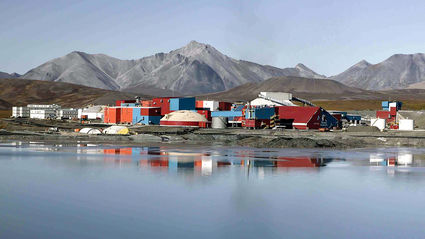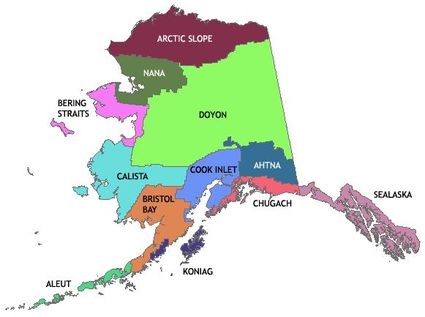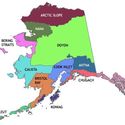An Alaska Native claims primer for miners
The path to developing a mine in Alaska goes through the state's First People; understanding the ANCSA landscape is key North of 60 Mining News – February 1, 2019
Last updated 9/25/2020 at 10:47am

NANA Regional Corporation
Red Dog, which accounts for roughly 5 percent of global zinc mine production, is located on lands owned by NANA, the ANCSA regional corporation for Northwest Arctic.
Alaska boasts what many consider the most successful Aboriginal land claims settlement on Earth – a solution that has not only turned out to be a cultural success, but a brilliant business move for the more than 140,000 Alaska Natives and an economic boon for the state that covers the resource-rich lands these industrious and innovative peoples have called home for millennia.
Signed into law by U.S. President Richard Nixon in 1971, the Alaska Native Claims Settlement Act, commonly referred to as ANCSA, involved a unique plan to organize Alaska Natives into 12 regional corporations, with each of these corporations having its own geographical regions based largely on heritage and shared interests.
A thirteenth regional corporation was established for those Alaska Natives residing outside the state.
More than 240 village corporations were also established under ANCSA. Some village corporations within regions have merged to form stronger business entities with shared interests and in at least one instance the village and regional corporations have merged to provide a consolidated body for doing business.
Eligible Alaska Natives had the opportunity to be issued shares in both a regional and village corporation at the time ANCSA was formed, shares that cannot be sold.
While placing aboriginal peoples who put more value into a successful whale hunt in Utqiaġvik (formerly Barrow) than being a wolf on Wall Street in a western corporate boardroom may not seem like a good fit, a look back from 47 years later proves otherwise.
Alaska Native regional and village corporations make up 17 of the top 20 Alaska-owned businesses listed on the Top 49ers, an annual list published by the Alaska Business magazine that ranks Alaska-owned businesses by gross revenue.
The Alaska Native-owned business titans that now dominate the top of this list have achieved much of their corporate success off the natural resources found on the 44.7 million acres of lands they will own once all lands guaranteed under ANCSA are conveyed, an area about the size of Oklahoma.
While they have title to just over 10 percent of Alaska, their regions, or traditional territories cover every square inch of the Far North State.
These corporations also own a wide range of businesses, both at home and globally, many of which provide the services vital to mineral exploration, mine development and mining in Alaska.
This makes ANCSA corporations important partners to mining companies seeking to explore and develop Alaska's vast mineral potential.
Prime mineral real estate
Aside from being a good neighbor to the peoples that have called Alaska home for some 15,000 years, one of the primary reasons mining companies want to build solid relationships with the ANCSA corporations is that these major landholders have some of the prime mineral real estate across the Last Frontier.
Red Dog, which accounts for roughly 5 percent of the global zinc mine production, for example, is located on lands owned by NANA Regional Corp., the regional Alaska Native corporation for Northwest Arctic.
Donlin Gold, a 39-million-ounce gold mine project situated on lands owned by Calista Corp. and The Kuskokwim Corp., is another example of the rich mineral tenures ANCSA corporations identified and selected for ownership.
The regional-village co-ownership at Donlin brings up an important point that any mining company planning to do business in Alaska should understand. Much of the lands selected under ANCSA are split estate, with the regional corporations owning the subsurface rights and the village corporations owning the surface estate.
In addition to their resource potential, the lands Alaska Native corporations selected under ANCSA were based on traditional, infrastructure and other strategic uses.
Sometimes, however, regional corporations will own both the surface and subsurface rights.
It is often the case that a mineral exploration company will establish a solid agreement on mineral rights with the regional corporations and early stage surface agreements with the village corporations before exploration begins. Once a deposit is established to the point that the economics of a mine are being considered, and the details of what surface lands will be needed for a potential mine and its supporting infrastructure begin to emerge, longer term surface land use, hiring, contracting, subsistence and other agreements are then struck.
Crafted successfully – and carried out in a way that provides economic benefits, while respecting the traditional values of the surface and mineral rights landholders – these agreements form the basis for a strong and enduring partnership.
Unique Red Dog agreement
The Red Dog Mine, operated by Teck Resources Ltd. in partnership with NANA, is a prime example of the success that can be achieved by building strong partnerships with ANCSA corporations.
While early negotiations between the mining company and the Northwest Alaska Native corporation were rough, by 1982 Cominco (now Teck) and NANA signed a landmark agreement that directs how the mine is operated and ensures sustainable benefits for the region and its people.
This unique development and lease agreement mandated that Red Dog:
• Protect subsistence and the Inupiaq way of life;
• Create lasting jobs for NANA shareholders;
• Provide opportunities for NANA's youth; and
• Act as a catalyst for regional economic benefits.
It also gave NANA a direct ownership interest in the operation that results in healthy royalty payments on the net proceeds from the metals produced at Red Dog.
Teck paid off its capital and operating costs at Red Dog in 2007, triggering an increase in NANA's net proceeds royalty to 25 percent from the zinc mine.
Under the agreement, this net proceed royalty increases by 5 percent every five years, up to a maximum of 50 percent. In 2017, NANA's royalty from the net profits at Red Dog was bumped to 35 percent.
So far, NANA has received around $2 billion in net proceeds payments.
Red Dog also directly creates more than 700 full-time and temporary jobs in an area of Alaska where good-paying jobs would otherwise be scarce.
Today, around 57 percent of the roughly 600-person workforce at Red Dog are Alaska Natives, mostly NANA shareholders, who bring home an average annual wage of around US$100,000.
"It has been a revolutionary thing for our region economically and demonstrates the kind of development that can be done that not only benefits the local people but protects the environment," said Willie Hensley, who was active in the founding of NANA and subsequent development of Red Dog.
Nearly four decades after the landmark agreement, all signs point to the world class zinc mine continuing to serve as an economic engine in the Northwest Arctic for several decades to come.
Red Dog currently has enough high-grade zinc ore in reserves to keep the operation going until 2031 and new zinc deposits show the likelihood that this world-class mine will continue to be a globally significant supplier of this important base metal much deeper into the 21st Century.
"The mine was an opportunity to responsibly develop resources in this area of the state and provide economic development to the communities," NANA Vice President of External and Government Affairs Liv Cravalho informed Alaska lawmakers in 2018. "The mine continues to have a significant impact on the NANA region."
Building a solid relationship
The world-class Donlin Gold deposit is poised to provide a similar boost to the Calista region, which covers 58,000 square miles of the Yukon-Kuskokwim region of Southwest Alaska, an area about the size of New York state.
Donlin Gold LLC – a joint venture owned equally by Novagold Resources Inc. and Barrick Gold Corp. – has worked hard to build a solid relationship with the ANCSA corporations and people of Calista region.
This engagement began with a commitment to hiring local residents during the early exploration phase at the gold discovery and grown stronger over the ensuing two decades.
By 2008, nearly 90 percent of the more than 200 workers at the advanced exploration project were Calista shareholders, or their descendants.
June McAtee, former vice president of Calista's land department, told Mining News in 2009 that the key to the success of the shareholder-hire program at Donlin Creek is twofold – Calista's ownership of the land encompassing the Donlin Creek deposit, and Placer Dome, Barrick Gold and Novagold's longstanding commitment to hiring and training shareholders at the project.
"There has been a continual process of hiring and training shareholders from the very beginning. Even though the original company (Placer Dome) isn't there any more, the companies that came after it believed in those same concepts and did more than just pay it lip service. They actually acted on that, and took the lead, in fact, in the hiring and training," McAtee said.
Today, Novagold has taken what it has learned with working in the Calista region and enshrined that into its core values.
"Novagold believes that a company must earn its social license in any given region by establishing a strong and collaborative working relationship with the community where it operates," the company says on its website. "Moreover, this social license must be based on a solid foundation and thorough understanding of the language, values and culture of the people in the region."
While Donlin Gold has built a reputation for local hire, this commitment is preserved in agreements with Calista Corp. and The Kuskokwim Corporation.
This combination of shareholder hire, community engagement and strong agreements with Calista and TKC has earned Donlin Gold LLC strong endorsements by local leaders.
"As a mine that focuses on environmental responsibility, meaningful dialogue with communities, job opportunities, and economic stimulus for one of the poorest regions in the entire state, Donlin Gold has TKC's full support," said The Kuskokwim Corporation President and CEO Maver Carey.
Currently envisioned as a mine that will produce more than 1 million ounces of gold per year from 504.8 million metric tons of proven and probable reserves averaging 2.09 grams per metric ton (33.85 million oz) gold, Donlin Gold is expected to be a globally significant mine.
To develop this operation, Donlin Gold LLC anticipates paying out roughly $375 million in wages to around 3,000 workers during the three- to four-year construction phase. Once in production, the company expects a payroll of more than $100 million per year for the minimum of 800 workers that would be needed at the mine currently being considered. In addition to this direct employment, Donlin Gold is expected to spur about another US$60 million a year worth of jobs.
While not all these jobs will be filled by residents of the region, history indicates that a large portion of them will.
Donlin Gold has now reached the end of the permitting process and the project partners are expected to decide on developing this world-class gold project in the near future.
"Ultimately, economic development of such a large project will help fulfill the broader goal of self determination by allowing residents and Calista shareholders to significantly participate in the world economy," said Calista President and CEO Andrew Guy.
Section 7(I) – sharing the hunt
While a regional corporation such as NANA or Calista can be elevated to a significant participant in the world economy through the development of a mine on the lands it owns, the economic benefits of such an endeavor is shared by all the ANCSA corporations, due to sections 7(i) and 7(j) of ANCSA.
ANCSA Section 7(i) requires Regional corporations to distribute 70 percent of net revenues from resource development on ANCSA land among all 12 regional corporations. In turn, Section 7(j) requires that half of the Section 7(i) payments received are distributed to the respective village corporations within each of the ANCSA regions.
While these provisions were primarily put into ANCSA as a way to bring balance to all the regional and village corporations by sharing the resource successes, they also fit well with millennia-long traditions of sharing the "proceeds" of successful hunts.
When it comes to Section 7(i) proceeds from mining, NANA has been by far the largest contributor.
Of the approximately $1.3 billion in proceeds NANA received from Red Dog through 2015, the most recent year for comprehensive data on Section 7(i) distribution, the Northwest Alaska Native corporation has made more than $820 million in 7(i) payments to the other ANCSA Regional corporations.
"That means we have a significant impact on the rest of the state and the other Alaska Native communities," said Vice President of External and Government Affairs Cravalho.
In total, mining has contributed $863 million to Section 7(i) distribution through 2015. When combined with oil and gas ($1.45 billion) and timber ($278 million), roughly $2.5 billion has been distributed through ANCSA Section 7(i) through 2015.
The "leveling effect" of sections 7(i) and 7(j) creates economic activity that otherwise would not occur in recipient regions and provides village corporations with vital funding.
Getting to know the people
Whether a mining company is looking to explore and develop mineral properties on Alaska Native, state or federal lands, understanding the landscape of the ANCSA regional and village corporations in the area is a key first step in the future success of the project.
In addition to earning that ever important social license, ANCSA regional and village corporations have much to offer Alaska's mining sector.
While sitting down with ANCSA regional, village and business leaders is a good start, getting to know the people in the region of Alaska a mining or mineral exploration company is planning to work provides an enormous advantage.
One of the primary rewards is recruiting a local workforce. Many of the ANCSA shareholders living in rural Alaska have worked in remote camps and have experience with the positions needed at mineral exploration projects. When you couple this work experience with lifelong and generational knowledge of living and working in the region, hiring local provides many advantages for mining companies.
Mining companies can also learn a lot about the area by sitting down and talking with local residents. Getting to know the "traditional knowledge" can pay dividends down the road.
This traditional knowledge could be finding out about a trapline that is in the same area as a potential deposit and being able to talk with the individual early in the process; getting generational insight into weather and wildlife; or even information on outcrops or other geological structures.
Understanding the landscape
From the prospector scouring Alaska's broad expanse for the next Red Dog or Donlin Gold, to the global miner looking to acquire a world-class deposit already found, the ultimate goal is to develop a mine that delivers the metals needed and wanted. This path inevitably leads to the people that have called these mineral-rich northern lands home for millennia and the corporations they are shareholders of.
Understanding the ANCSA landscape early could be the difference between efficiently permitting and developing a successful mine with strong local partners, or arduous work later to gain the social license and government permits needed to extract the rich mineral resources Alaska has to offer.

ANCSA involved a unique plan that created 12 Alaska Native regional corporations, with each having its own geographical regions based largely on heritage and shared interests.
For these reasons, an ANCSA map and information on the Alaska Native lands, people, corporations and businesses has a place among the geological maps and mineral data for any prospector, explorer or miner looking to unlock Alaska's vast mineral potential
EDITOR'S NOTE: "An Alaska Native claims primer for miners" is the first article in a 13-part series that investigates what the Alaska Native Claims Settlement Act means for Alaska's mining sector and its future. The coming 12 articles will dig deeper into each of the land-holding Regional corporations and the Village corporations within them; the mining lands that they own; and the services they offer to the mining sector. As a life-long Alaskan that has written about mining here for more than a decade, it is my hope that this series will provide a better understanding of ANCSA and serve as a guide to mining companies seeking to do business in The Last Frontier.





















Reader Comments(0)